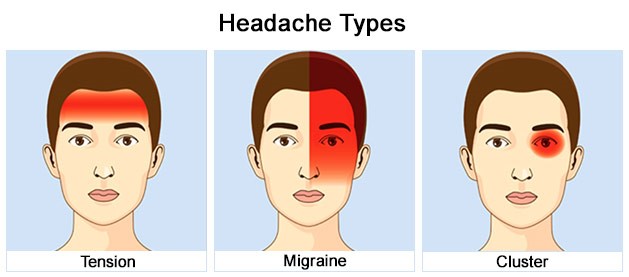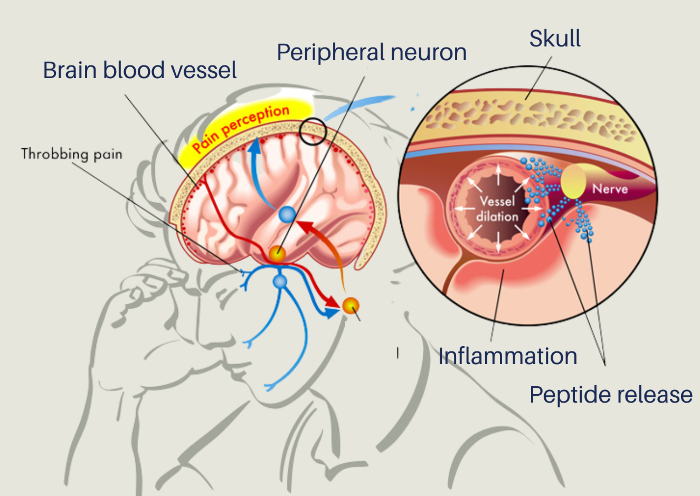
Headaches Migraines and Integrative Medicine
Having successfully treated several chronic migraines and headaches recently I wanted to share some of the science and the evidence behind the diagnosis and the treatments. Headaches migraines and integrative medicine: do reach out if you suffer from various headaches and migraines. I will try to write up some case studies soon to illustrate my process and showcase the success achieved with my patients (they have to be credited with at least 50% of the headache eradication by getting on this path of therapy and making the lifestyle adjustments that were recommended! Bravo!). This might be a bit long so I hope it doesn’t give you a headache! If it does you know where to find me to fix it!
What Is A Headache?
Tension-type headaches
They feel like a band of intense pressure around the head that gives no warnings before it happens. It can be caused by a lack of sleep, stress, depression, or anxiety. When the body is under stress, the liver can become upset (LV Qi Stagnation in TCM) leading to a deficiency in toxin processing which allows toxins and chemicals to accumulate in the blood. The high levels of toxins can enter into the brain and irritate the nerves that trigger tension-type headaches as well as emotional depression, and mood swings. These toxins typically come from processed foods or foods sprayed with pesticides.

Cluster headaches
They are a series of relatively short but extremely painful headaches that occur in cyclical patterns or cluster periods. It is one of the most painful types of headache that occurs on one side of the head, often behind or in or around one eye which may spread to the forehead, temple, nose, cheek, or upper gum with other symptoms such as eye redness or tearing and stuffy or runny nose on the affected side.
Cluster headaches often feel like piercing or burning and throbbing that reach their full force quickly within 5 or 10 minutes that last 30 to 90 minutes for each episode. It happens regularly at the same time each day for 2 weeks to 3 months followed by a 2-week pain-free period before the next episode. The cause of cluster headache is the widening or dilation of the blood vessels that supply blood to the brain and face around the eye area that applies pressure to the trigeminal nerve. The blood vessel dilation may be triggered by the chemicals released from the brain.
Hemicranias
They are persistent headaches that fluctuate in severity that usually affect the same side of the head. People can have daily, or chronic, headaches as well as other migraine symptoms including nausea and vomiting, sensitivity to light and sound, or sweating. Patients who suffer from hemicrania might experience periods of recurring headaches followed by headache-free periods. Physical exertion and alcohol use may increase headache severity. Hemicranias may be caused by irregular blood vessel contraction with vasoconstriction on the affected side. During the attack, the blood vessel of the affected side enters a state of lasting contraction that affects the blood circulation and causes headaches. Patients may also experience body coldness and fatigue or numbness on the affected side due to poor blood circulation caused by vasoconstriction.
Blood Vessel Dilation
It can also affect glymphatic system in the brain because the driving force of the glymphatic circulation is the rhythm of blood vessel contraction. The reduced amplitude of blood vessel contraction will cause reduced glymphatic drainage. The resulting accumulation of toxins in the affected area can irritate the nerves and cause headaches.
What About Migraines?
Migraines are a complex neurobiological disorder with symptoms of headaches, usually throbbing, intense, and debilitating as well as features of nausea, sensitivity to light, sound, and exacerbation with head movement. However, some types of migraines do not cause head pain. The episodes usually last anywhere from a few hours to several days and it is recurring with warning signs beforehand. The frequency with which migraine attacks occur vary person to person, from once in a lifetime to almost daily. Migraines mostly affect one side of the head, but some people experience pain on both sides.

Migraines have a distinct set of four phases, although not everyone experiences every phase; prodrome, aura, headache, and postdrome.
Prodrome
Also known as the pre-headache, marks the beginning of a migraine attack. Symptoms of prodrome can vary in individuals but commonly consist of changes in mood, fatigue, sensitivity to light, insomnia, nausea, and muscle stiffness.
Aura
Up to one-third of people who suffer from migraines experience aura. During the aura phase, patients can endure periods of blurry vision, vision loss, the appearance of geometric patterns, flashing lights, and blind spots. This phase can last 5 minutes up to 60 minutes.
Headache Phase
The headache phase of a migraine attack is characterized by pain on one or both sides of the head. This is the longest of the phases, which can last from several hours up to three days. The pain experienced during the headache phase varies from mild pain to debilitating pain. During this phase, everyday activities like turning on a light or physical activity can aggravate the migraine.
Postdrome
It occurs after the end of the headache phase, includes symptoms of fatigue, body aches, and dizziness.
Migraines As Mini Strokes
Migraines are believed to be caused by blood-vessel micro emboli, often a blood clot, which becomes caught in the brain and causes blockage in a cerebral blood vessel. The cause of the blood clot formation is often due to chronic blood vessel inflammation. A micro emboli in a severe case can cause stroke when it stays in the blood vessel for too long to trigger an infarction. While in a mild case it can trigger a migraine when the micro emboli are stuck for a short period, but long enough to induce cortical spreading depression (CSD).
CSD is a slowly propagating wave of the surrounding brain tissue occurring during the aura that is characterized by ionic shifts with a massive increase of extracellular potassium and rises in intracellular sodium and calcium which produces a slow direct current. These electrical currents trigger the release of various brain chemicals and the neurotransmitter glutamate which leads to an acute inflammation of blood vessels and nerves. The resulting inflammation causes symptoms of a migraine including the throbbing pain, nausea, and sensory sensitivities. Hypo perfusion and hypoxia due to restricted blood flow can also provoke migraine headaches.
Role of the Glymphatic System
The CSD wave also restricts the glymphatic space. The glymphatic system is the perivascular pathway for waste clearance from the brain interstitial fluid. Glymphatic flow significantly decreases in the period just before a migraine as the CSD wave passes. This impairment of glymphatic flow may compromise the clearance of a variety of extracellular excitatory and inflammatory chemicals. This causes intense pain caused by inflamed nerves in the tissue that surrounds the brain. As a result of the faulty clearance of molecular waste from the brain, inflammation in pain fibers can be triggered.

But What About Your Treatments, Dr Kroner?
Before a successful treatment comes a successful diagnosis!
In Traditional Chinese Medicine (TCM), several factors that may cause headaches and migraines have been identified based on patient symptoms. These can include Liver Yin Deficiency, Liver Yang Rising and/or Liver Wind, deficiency of both Qi and Blood that can lead to Blood Stagnation. Also Cold Wind-Cold, Spleen Phlegm Damp Heat and Blood Stagnation. My most common diagnosis are Liver yang Rising, Qi and Blood Deficiency and Blood Stagnation.
Although for a single case, the cause may be multiple factors, usually, the tension-type headache is caused by a Liver Yin deficiency which requires nurturing the liver. A cluster headache is usually caused by Qi and Blood Deficiencies and Blood Stagnation causing the blockage of blood circulation and required treatment includes Qi and Blood enhancement and clearing of Blood Stagnation in the brain. The resulting Spleen and Phlegm Damp from Blood Stagnation requires treatment to clear Spleen and Phlegm Damp. A hemicrania is usually caused by Liver Yang Rising and Liver Wind which requires clearing the Liver Heat as well as soothing Liver Yang and Liver Wind. Migraines are usually caused by Heat and Blood Stagnation and treatment requires clearing Heat and moving and invigorating Blood (and Qi).
All successful headache and migraine treatments involve acupuncture, auricular acupuncture (more success with retained ASP needles), diet and lifestyle adjustments, appropriate exercise (I always recommend Qi Gong – watch video the 8 Pieces of Brocade) and custom herbal formulas and/or OTC supplements.
Thanks for reading that far and I hope this didn’t cause a headache! If you suffer from chronic headaches or migraines and are seeking long lasting relief you know where to find me!
Sources + References
- Merck Manual – Migraines
- Merck Manual – Headaches Overview
- Dönmez-Demir B;Yemisci M;Kılıç K;Gürsoy-Özdemir Y;Söylemezoğlu F;Moskowitz M;Dalkara T;, B. (n.d.). Micro embolism of Single Cortical Arterioles Can Induce Spreading Depression and Ischemic Injury; A Potential Trigger for Migraine and Related MRI Lesions. Retrieved from https://pubmed.ncbi.nlm.nih.gov/29183666/
- Parts adapted from Wei Labs migraine section & presentations,

